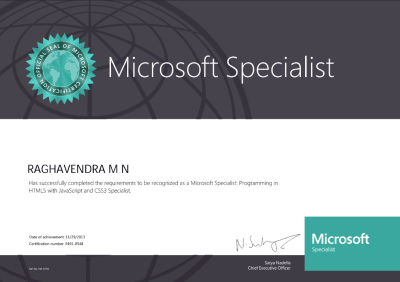Table of contents
Open Table of contents
Approaching the Microsoft Certified HTML5 with JavaScript and CSS3 Exam (MCTS 70-480)
Introduction
As a senior .NET developer, I recently undertook the challenge of obtaining the Microsoft Certified HTML5 with JavaScript and CSS3 certification (MCTS 70-480). This exam is designed to validate your skills and knowledge in building web applications using HTML5, JavaScript, and CSS3. In this technical blog, I will share my approach to preparing for and approaching this exam, providing valuable insights and tips for fellow developers.
Exam Overview
Before diving into the preparation strategy, it’s important to understand the key topics and objectives of the MCTS 70-480 exam. The exam covers the following areas:
- Implement and Manipulate Document Structures and Objects (20-25%)
- Implement Program Flow (25-30%)
- Access and Secure Data (25-30%)
- Use CSS3 in Applications (25-30%)
Preparation Strategy
To successfully tackle the exam, a structured preparation strategy is essential. Here are the steps I followed to effectively prepare for the MCTS 70-480 exam:
1. Familiarize Yourself with Exam Objectives
Start by thoroughly reviewing the exam objectives provided by Microsoft. These objectives outline the specific skills and knowledge areas that will be assessed in the exam. Familiarize yourself with each objective to understand what you need to focus on during your preparation.
2. Gather Study Materials
Next, gather relevant study materials that will aid you in your preparation. Here are some resources I found valuable:
-
Microsoft Official Courseware (MOC): Microsoft offers official training courses specifically designed for exam preparation. These courses provide comprehensive coverage of the exam topics and often include hands-on exercises to reinforce your understanding.
-
Online Tutorials and Documentation: There are numerous online tutorials, blog posts, and official documentation available that cover HTML5, JavaScript, and CSS3 concepts. Websites like MDN Web Docs and W3Schools offer detailed and reliable information on these technologies.
-
Practice Tests: Practice tests are an excellent way to assess your knowledge and identify areas that require further study. Several websites offer practice exams designed to simulate the actual exam experience.
3. Create a Study Plan
Establish a study plan that suits your schedule and allows you to allocate sufficient time to cover all the exam objectives. Break down your study plan into smaller, manageable topics and allocate specific time slots for each.
4. Dive into the Topics
Now that you have your study plan in place, dive into each topic systematically. Here’s how I approached the main exam objectives:
Implement and Manipulate Document Structures and Objects
- Understand the Document Object Model (DOM) and how to interact with it using JavaScript.
- Master HTML5 semantic elements and their usage.
- Learn how to create and modify HTML5 forms and validate user input.
Implement Program Flow
- Gain a solid understanding of JavaScript control structures, including loops, conditionals, and exception handling.
- Practice working with JavaScript functions and scope.
- Study how to manipulate and traverse arrays and collections.
Access and Secure Data
- Learn how to make asynchronous requests using JavaScript (AJAX) and handle responses.
- Understand different data formats such as JSON and XML and how to parse and manipulate them.
- Study techniques for data validation and client-side data storage using Web Storage APIs.
Use CSS3 in Applications
- Familiarize yourself with CSS3 selectors, properties, and values.
- Study CSS box model, layout techniques, and positioning.
- Learn about CSS3 transitions, transformations, and animations.
5. Hands-on Coding
To reinforce your understanding of the concepts, hands-on coding practice is essential. Implement small projects
and exercises to apply the knowledge you’ve acquired. Working on practical examples will help you become more comfortable with the technologies and concepts covered in the exam.
6. Review and Practice Tests
Regularly review the topics you’ve covered to solidify your understanding. Additionally, take practice tests to evaluate your knowledge and identify any weak areas. Practice tests will also familiarize you with the exam format and timing, helping to reduce exam-day stress.
Exam Approach
Now that you have prepared for the exam, it’s important to approach the actual exam strategically. Here are some tips for the exam day:
-
Read the Questions Carefully: Take your time to read each question carefully, ensuring that you understand the requirements before attempting an answer.
-
Manage Your Time: The exam duration is limited, so manage your time wisely. If you encounter a difficult question, mark it and move on. Return to it later if you have time remaining.
-
Eliminate Incorrect Options: If you’re unsure about the correct answer, try to eliminate obviously incorrect options. This increases your chances of selecting the right answer even if you’re not entirely certain.
-
Review Your Answers: If you finish the exam before time runs out, go back and review your answers. Double-check for any mistakes or overlooked details.
-
Stay Calm and Focused: Keep a calm and focused mindset throughout the exam. Avoid rushing and maintain a steady pace.
Conclusion
The Microsoft Certified HTML5 with JavaScript and CSS3 (MCTS 70-480) exam is a valuable certification for web developers. By following a structured preparation strategy and approaching the exam strategically, you can increase your chances of success. Remember to practice regularly, review the exam objectives, and stay up to date with the latest industry standards. Best of luck in your exam preparation, and may you achieve your certification goals!
Note: This blog post is based on my personal experience and may vary depending on individual learning styles and preferences.
Good luck, and keep Learning!!
